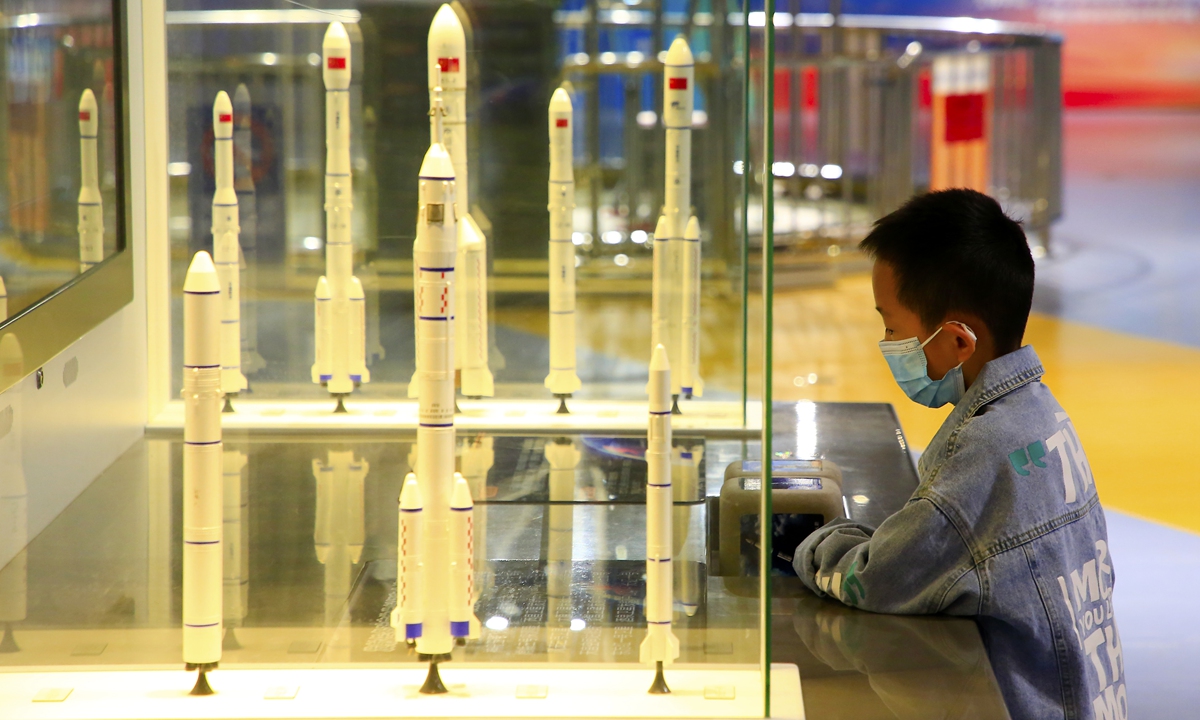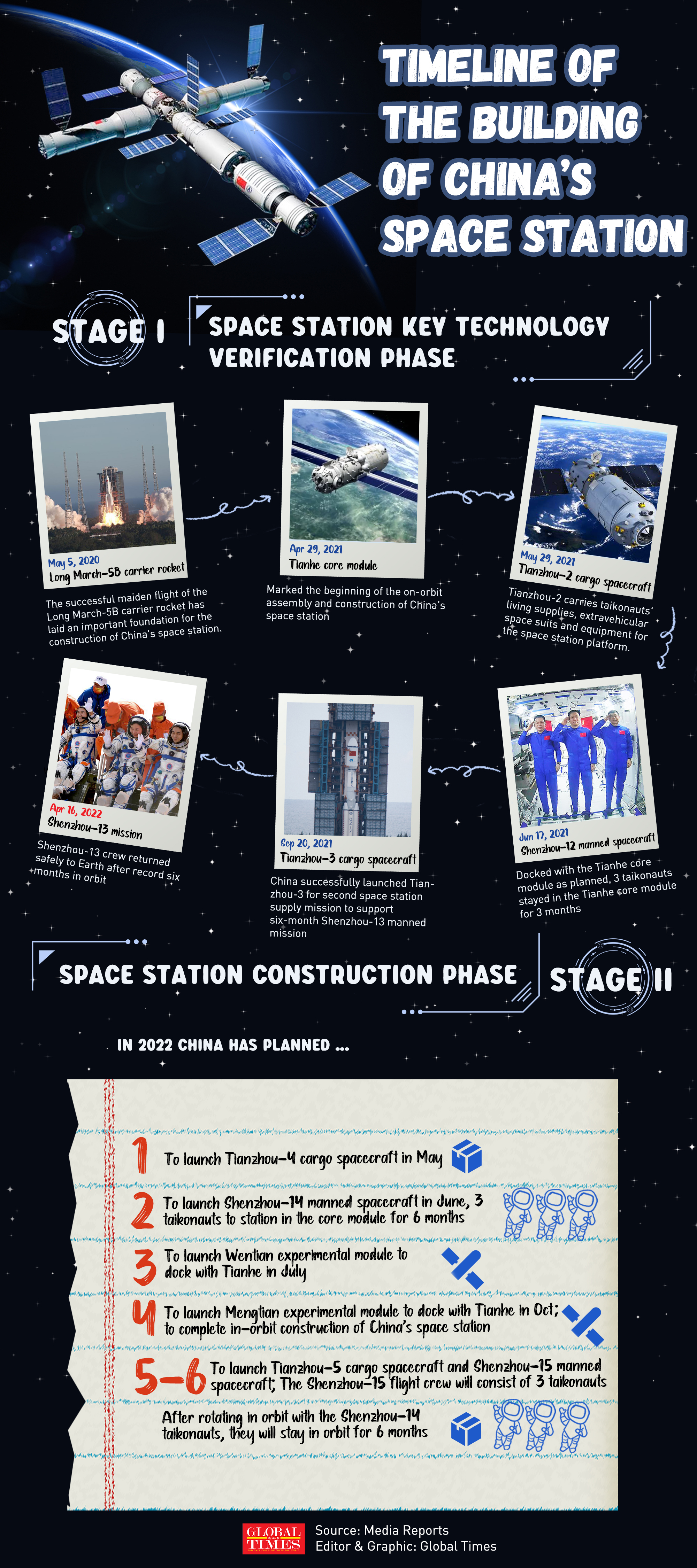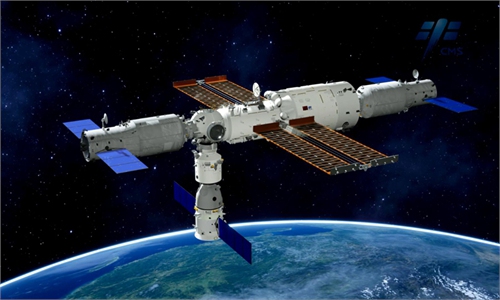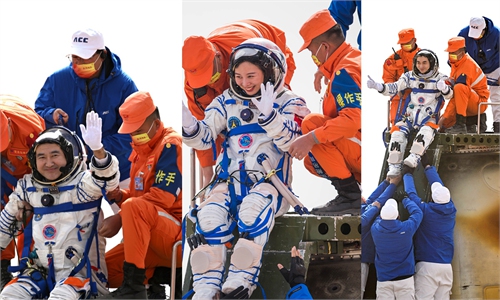China eyes next-generation manned carrier rocket, spaceship
New types featuring reusability, to support sending seven taikonauts in one go

A boy views a model of the Shenzhou spaceship at an aerospace science education exhibition at the Ningxia Science and Technology Museum in Yinchuan, Northwest China's Ningxia Hui Autonomous Region on April 17, 2022. Photo: VCG
With the epic Shenzhou-13 mission drawing a perfect conclusion to the key technology verification stage of China's space station Tiangong, the China Manned Space Agency (CMSA) revealed on Sunday that six more flights will be arranged this year to complete the station's construction. Tiangong will then enter the operational stage that will run for over 10 years, becoming a space "home" for all mankind.
For the next step, authorities with the CMSA disclosed at Sunday's press conference that they are developing a next-generation manned carrier rocket and spacecraft, which will enable their return capsules to be reusable and support sending seven taikonauts in one go, a significant boost in the payload capacity.
After having stayed for 183 days in orbit, the Shenzhou-13 crew safely returned to Earth on Saturday, doubling the previous record set by the Shenzhou-12 to become the country's longest single-flight space mission.
Hao Chun, director of the CMSA, said at the press conference that the success of the Shenzhou-13 signaled a perfect completion of the key technology verification stage for China's space station, and six more flights are scheduled to complete the station's construction by the end of this year.
With 2022 marking the 30th anniversary of the establishment of the country's manned space engineering project, the completion of Tiangong is a key target of the three-step strategy for the project, and an important symbol of China becoming a strong space power in the world, he noted.
The six flights will be the Tianzhou-4 cargo spacecraft, another supply run for the next shift, to be launched in May; the Shenzhou-14 manned mission in June; the Wentian experimental module in July; the Mengtian experimental module in October; another cargo mission, the Tianzhou-5, and a manned mission, the Shenzhou-15.
The Wentian module is equipped with the same living facilities as the Tianhe core module, which includes three sleeping areas, a sanitary area and kitchen facilities. Together with Tianhe, they can support the docking of two manned spacecraft and accommodate as many as six taikonauts, authorities said.

Timeline of the building of China's Space Station
Bai Linhou, deputy chief designer of China's space station, told the Global Times that the Wentian module is positioned to carry out space science experiments inside and outside the cabin. It has an airlock through which taikonauts can exit, and a small robotic arm that can be used alone or combined with the large mechanical arm of the space station.
It can also serve as a backup to Tianhe. If a malfunction occurs in the core cabin, the Wentian module can replace it immediately, improving the reliability of the entire station's operation, Bai said.
The other lab module, the Mengtian, has a cargo airlock. The small robotic arm on the lab module can grab payloads via the airlock and install them on the experiment platform outside the cabin.
The verification and assembly work of the two modules are progressing smoothly. Upon completion, the space station will form a T-shaped structure with a cabin room of more than 110 cubic meters.
The Shenzhou-14 and -15 manned missions, which will each have three members, will meet and stay together in the station for about five to 10 days when the two crews rotate, said Huang Weifen, head of taikonauts training at the CMSA. It means that China's space station will have, for the first time, six taikonauts staying in orbit at the same time, testing the station's maximum capacity for human stays in the short term.
Next year, China plans to launch its first large-scale telescope called Xuntian, or "survey the heavens." It will have a 2-meter diameter lens, which according to space.com, a professional news website covering space activities around the world, makes it "comparable to the Hubble Space Telescope," only boasting a field of view 300 times greater than that of the 31-year-old Hubble while retaining a similar resolution.
China's telescope will conduct wide-area sky survey observations, and carry out frontier scientific research into the formation and evolution of the universe, dark matter and dark energy, among others.
In addition, China plans to develop a next-generation manned carrier rocket and spacecraft to support the future routine of two manned missions each year. They will allow seven taikonauts to be sent to the station in one go, and the return capsule for both the launch vehicle and the spaceship will be reusable.
An extended segment of the space station is also under consideration, so as to create better living conditions for taikonauts and better support for scientific experiments in orbit.
As the International Space Station will possibly retire after 2024, China's Tiangong is likely to become the only operational space station in the world. In an exclusive interview with the Global Times on Saturday, Bai said that China's space station is an inclusive one and has been designed in a way that foreign astronauts can adapt to.
Once Tiangong enters the operational phase, Bai said, foreign astronauts will have two ways to enter China's space station - by a Chinese spacecraft, or by their own spacecraft with a docking interface suitable to Tiangong.
When asked whether China's Tiangong will become a station shared by all mankind, Bai replied with confidence, "absolutely yes."


